
Our members know that buying pre earnings straddles is one of our most consistent and profitable strategies. Yet some options "gurus" continue conducting studies, trying to prove that the strategy doesn't work. Today we will show how to do the backtesting properly, using the CML TradeMachine, the best backtester in the industry.
We already debunked some of those "studies" here and here. Today we will debunk another study, and will show how to do it properly.
On July 7, 2015, tastytrade conducted a study using AAPL, GMCR, AMZN and TSLA. An ATM straddle was purchased 21 days prior to earnings and closed the day before earnings. A table showed the results. The win rate, total P/L, average P/L per day, biggest win and biggest loss were shown:
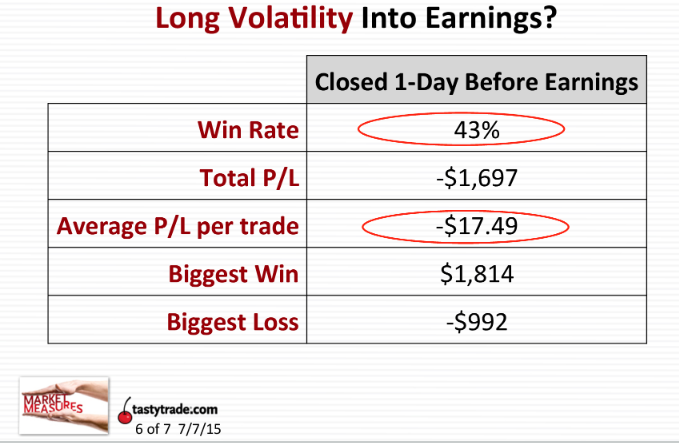
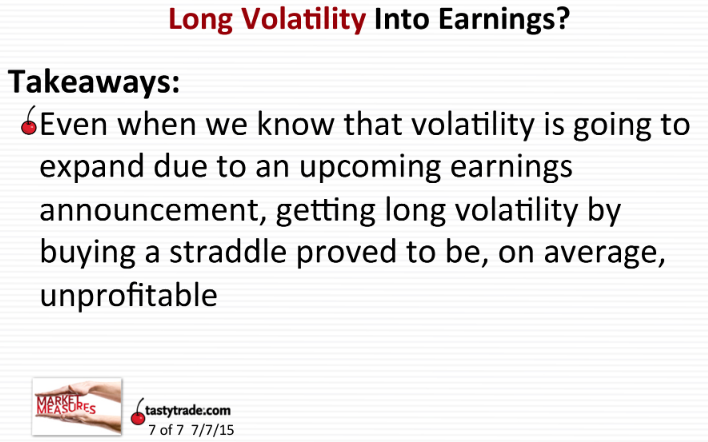
Wait. They concluded that buying volatility prior to earnings doesn't work based on 4 stocks? Why those 4 specific stocks? Why 21 days prior to earnings?
Our members know that those 4 stocks are among the worst to use for this strategy. They also know that entering 21 days prior to earnings is usually way too early (there are some exceptions).
Also, what is a significance of dollar P/L when comparing stocks like AMZN and AAPL? At current prices, AMZN straddle would cost around $8,500 while AAPL straddle around $1,200. Theoretically, if we had a 10% loss on AMZN (-$850) and 50% gain on AAPL ($600), the total P/L would be -$250total P/L of +40%
But lets see how changing just one parameter can change the results dramatically. We will be using AAPL as an example.
First lets use the study parameter of 21 days.
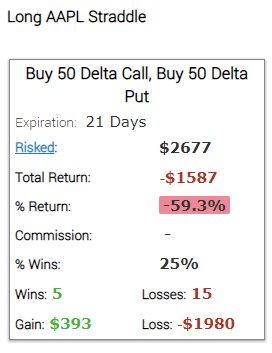
Tap Here to See the back-test
Entering 21 days prior to earnings is indeed a losing proposition. But lets change it to 10 days and see what happens:
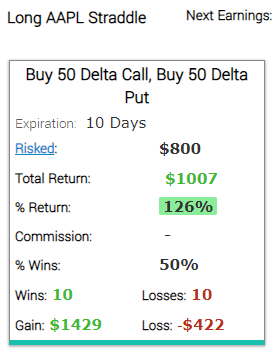
Tap Here to See the back-test
Can you see how changing one single parameter changes the results dramatically? I have a feeling that tastytrade knew that 21 days would be not the best time to enter - but using different parameters wouldn't fit their thesis.
Now lets test the strategy on some of our favorite stocks.
NKE, 14 days and 15% profit target:

Tap Here to See the back-test
MSFT, 7 days and 15% profit target:
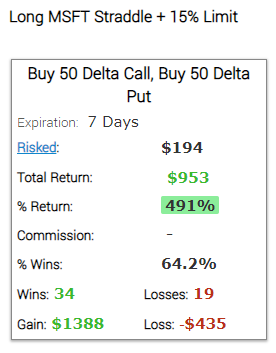
Tap Here to See the back-test
CSCO, 21 days and 10% profit target:
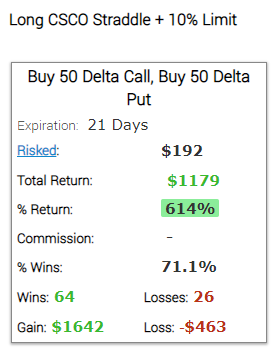
Tap Here to See the back-test
IBM, 7 days and 15% profit target:
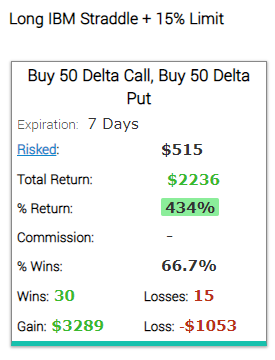
Tap Here to See the back-test
ORCL, 14 days and 20% profit target:
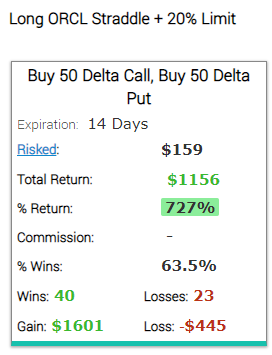
Tap Here to See the back-test
WMT, 7 days and 10% profit target:
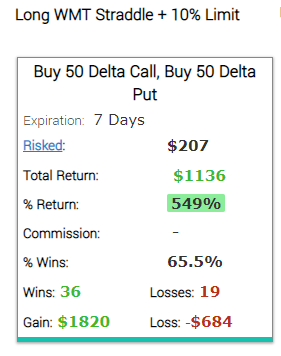
As you can see, different stocks require different timing and different profit targets. Some work better entering 7 days prior to earnings, some might improve performance with an entry as early as 21 days prior to earnings.
The bottom line is: you cannot just select random stocks, combine it with random timing and no trade management, and declare that the strategy doesn't work
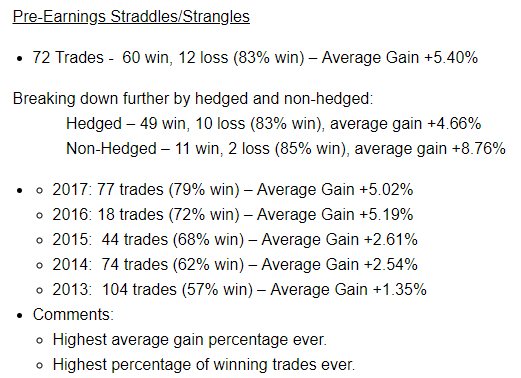
What Is SteadyOptions?
Full Trading Plan
Complete Portfolio Approach
Diversified Options Strategies
Exclusive Community Forum
Steady And Consistent Gains
High Quality Education
Risk Management, Portfolio Size
Performance based on real fills
Non-directional Options Strategies
10-15 trade Ideas Per Month
Targets 5-7% Monthly Net Return
Recent Articles
Articles
Pricing Models and Volatility Problems
Most traders are aware of the volatility-related problem with the best-known option pricing model, Black-Scholes. The assumption under this model is that volatility remains constant over the entire remaining life of the option.
By Michael C. Thomsett, August 16

- Added byMichael C. Thomsett
- August 16
Option Arbitrage Risks
Options traders dealing in arbitrage might not appreciate the forms of risk they face. The typical arbitrage position is found in synthetic long or short stock. In these positions, the combined options act exactly like the underlying. This creates the arbitrage.
By Michael C. Thomsett, August 7

- Added byMichael C. Thomsett
- August 7
Why Haven't You Started Investing Yet?
You are probably aware that investment opportunities are great for building wealth. Whether you opt for stocks and shares, precious metals, forex trading, or something else besides, you could afford yourself financial freedom. But if you haven't dipped your toes into the world of investing yet, we have to ask ourselves why.
By Kim, August 7

- Added byKim
- August 7
Historical Drawdowns for Global Equity Portfolios
Globally diversified equity portfolios typically hold thousands of stocks across dozens of countries. This degree of diversification minimizes the risk of a single company, country, or sector. Because of this diversification, investors should be cautious about confusing temporary declines with permanent loss of capital like with single stocks.
By Jesse, August 6

- Added byJesse
- August 6
Types of Volatility
Are most options traders aware of five different types of volatility? Probably not. Most only deal with two types, historical and implied. All five types (historical, implied, future, forecast and seasonal), deserve some explanation and study.
By Michael C. Thomsett, August 1

- Added byMichael C. Thomsett
- August 1
The Performance Gap Between Large Growth and Small Value Stocks
Academic research suggests there are differences in expected returns among stocks over the long-term. Small companies with low fundamental valuations (Small Cap Value) have higher expected returns than big companies with high valuations (Large Cap Growth).
By Jesse, July 21

- Added byJesse
- July 21
How New Traders Can Use Trade Psychology To Succeed
People have been trying to figure out just what makes humans tick for hundreds of years. In some respects, we’ve come a long way, in others, we’ve barely scratched the surface. Like it or not, many industries take advantage of this knowledge to influence our behaviour and buying patterns.

- Added byKim
- July 21
A Reliable Reversal Signal
Options traders struggle constantly with the quest for reliable
By Michael C. Thomsett, July 20

- Added byMichael C. Thomsett
- July 20
Premium at Risk
Should options traders consider “premium at risk” when entering strategies? Most traders focus on calculated maximum profit or loss and breakeven price levels. But inefficiencies in option behavior, especially when close to expiration, make these basic calculations limited in value, and at times misleading.
By Michael C. Thomsett, July 13

- Added byMichael C. Thomsett
- July 13
Diversified Leveraged Anchor Performance
In our continued efforts to improve the Anchor strategy, in April of this year we began tracking a Diversified Leveraged Anchor strategy, under the theory that, over time, a diversified portfolio performs better than an undiversified portfolio in numerous metrics. Not only does overall performance tend to increase, but volatility and drawdowns tend to decrease: